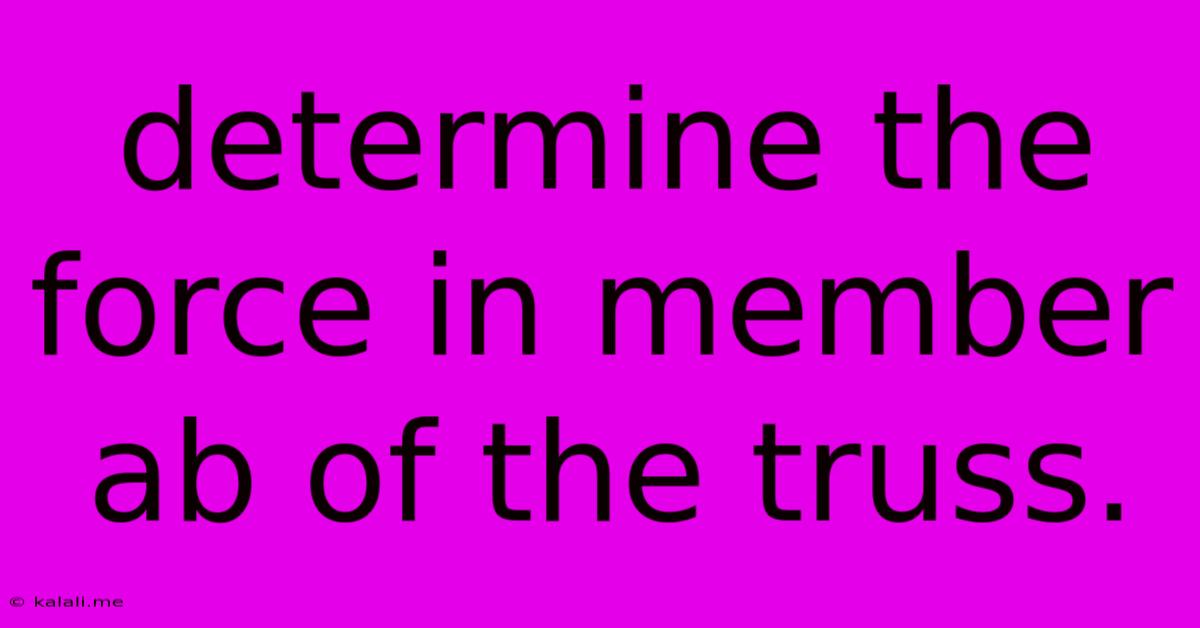Determine The Force In Member Ab Of The Truss.
Kalali
Jun 13, 2025 · 3 min read

Table of Contents
Determining the Force in Member AB of a Truss: A Step-by-Step Guide
Determining the internal forces within truss members is a fundamental concept in structural analysis. This article provides a comprehensive guide on how to calculate the force in member AB of a typical truss structure. Understanding this process is crucial for engineers and students alike, ensuring structural integrity and safety. We'll cover different methods, focusing on the method of joints and providing practical examples.
What is a Truss?
A truss is a structural assembly composed of slender members interconnected at their ends to form a rigid framework. These members are typically subjected to axial forces (tension or compression). Trusses are widely used in bridges, roofs, and other structures where lightweight and efficient load distribution is essential. Understanding how to analyze these forces is vital for structural design.
Methods for Analyzing Truss Forces
Several methods exist for determining the internal forces in truss members, including:
- Method of Joints: This method analyzes the equilibrium of forces at each joint (node) of the truss. It's a straightforward approach, particularly useful for simpler trusses.
- Method of Sections: This method involves cutting through the truss to isolate a section containing the member of interest. Equilibrium equations are then applied to the isolated section. This is often more efficient for larger, more complex trusses.
Method of Joints: A Detailed Example
Let's focus on the method of joints to determine the force in member AB. We will assume a simple truss with known loads and support reactions. For this illustration, let's assume the following:
- A simple truss with a load at point C.
- Support reactions at points A and E are known (let's assume they have been calculated previously).
Steps:
-
Draw a Free Body Diagram (FBD): Begin by drawing a free body diagram of the entire truss, showing all external forces (loads and reactions).
-
Isolate a Joint: Start with a joint that has only two unknown forces. This often simplifies the calculations. For our example, joint A is an excellent starting point because we know the reaction force at A and only have two unknown members connected to it (AB and AD).
-
Apply Equilibrium Equations: Apply the equations of equilibrium: ΣFx = 0 and ΣFy = 0. These equations state that the sum of the forces in the x and y directions must equal zero for the joint to be in equilibrium.
-
Solve for Unknown Forces: Use the equilibrium equations to solve for the unknown forces in members AB and AD. Remember to consider the direction of the forces (tension or compression). A positive force indicates tension, while a negative force indicates compression.
-
Repeat for Other Joints: Continue this process, moving from joint to joint, until all unknown member forces are determined. Properly labeling the forces (tension or compression) using arrows and conventions is crucial for accurate analysis.
Important Considerations:
- Assumptions: Trusses are typically analyzed assuming that members are pin-connected at joints and that all loads are applied at the joints.
- Units: Maintaining consistent units throughout your calculations is essential.
- Accuracy: Check your answers to ensure they are reasonable and consistent with the overall structure's behavior.
Conclusion:
The method of joints provides a relatively simple and effective way to determine the forces in members of a truss. By carefully following the steps outlined above, and practicing with different examples, you will gain a strong understanding of this fundamental concept in structural analysis. Remember that the complexity of the calculation will increase with the size and complexity of the truss, but the fundamental principles remain the same. This process is vital for ensuring the stability and safety of any structure built using a truss system. Mastering this technique is crucial for engineers and anyone working with structural designs.
Latest Posts
Latest Posts
-
20 Is 60 Of What Number
Jun 13, 2025
-
6999 Rounded To The Nearest 10
Jun 13, 2025
-
What Is The Factors Of 89
Jun 13, 2025
-
Every 4 Way 2 Lane Intersection Has How Many Conflict Points
Jun 13, 2025
-
Buying And Selling Goods And Services Electronically Is Called
Jun 13, 2025
Related Post
Thank you for visiting our website which covers about Determine The Force In Member Ab Of The Truss. . We hope the information provided has been useful to you. Feel free to contact us if you have any questions or need further assistance. See you next time and don't miss to bookmark.